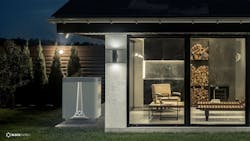Florida PSC Approves Neighborhood Microgrid to be Owned and Operated by a Utility
The Florida Public Service Commission approved a four-year neighborhood microgrid program proposed by Tampa Electric (TECO) that includes battery storage and solar photovoltaic equipment at customer homes.
BlockEnergy system. Courtesy of Emera Technologies
TECO will install Emera Technologies’ plug-and-play neighborhood microgrid system called BlockEnergy. The system is designed to be owned and operated by utilities.
In its June 15 decision approving the pilot project, the PSC capped its cost at $2 million.
Microgrid for residential neighborhood
The microgrid will cover up to 37 homes in the Medley at Southshore Bay housing development in Hillsborough County, which is home to Tampa.
Participating homes will have an inverter to convert the direct current microgrid power to alternating current for the house, along with an average of 7.8 kW of rooftop solar and 17.7 kWh of battery storage, PSC staff said in a memo recommending the commission approve the project.
Each house will have a Block Box, built by Emera Technologies, that contains the inverter, battery storage and related control equipment. The Block Box will connect the house with the solar array and the DC microgrid.
Also, TECO will install 240 kWh of battery storage and a pair of reciprocating natural gas generators totaling 350 kW at a “community energy park.”
The Block Box control equipment and energy park will connect by fiber optic cables to the housing development’s network and will manage power across the microgrid using a control algorithm.
Power from the project could be exported to support TECO’s bulk system.
Staff cautious
Participating customers will not see direct energy savings from the project like they would through customer-owned or leased solar installations, according to PSC staff.
However, they may experience a slightly higher level of reliability when compared to other residents in the same subdivision, which is supplied by an underground power line, staff said.
The potential system benefits of the pilot program depend on customers’ willingness to pay a premium for incremental reliability benefits, according to staff.
Test of neighborhood microgrid benefits
Through the project, TECO aims to test the ability of the neighborhood microgrid to ride through upstream AC distribution system disturbances, integrate high levels of renewable energy and reduce the effects of peak load on the utility’s transmission and distribution system.
If the project meets the goals, TECO contends its benefits will include increased renewable penetration, reduced system losses, reduced generation capacity costs, reduced system transmission and distribution capacity costs, reduced energy costs and increased reliability.
A microgrid model for utilities
PSC staff said Emera Technologies advertises its system as a business opportunity for investor-owned utilities to own and earn a return on equipment that would otherwise be customer-owned and behind-the-meter.
TECO plans to recover the project’s costs in a separate rate case.
The utility will file annual reports on the project at the PSC. In the project’s third year, TECO will ask participating customers about their willingness to pay more for increased grid reliability.
One participating home was built and occupied, with construction underway on 19 other homes as of March 1, according to PSC staff.
Track news about neighborhood microgrid projects. Subscribe to the free Microgrid Knowledge Newsletter.







